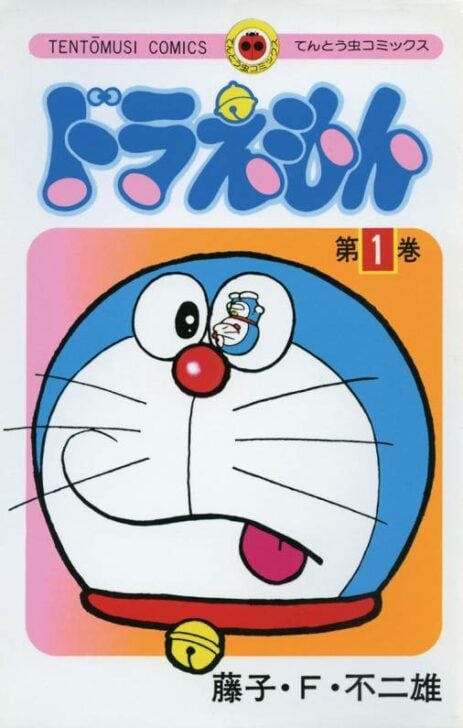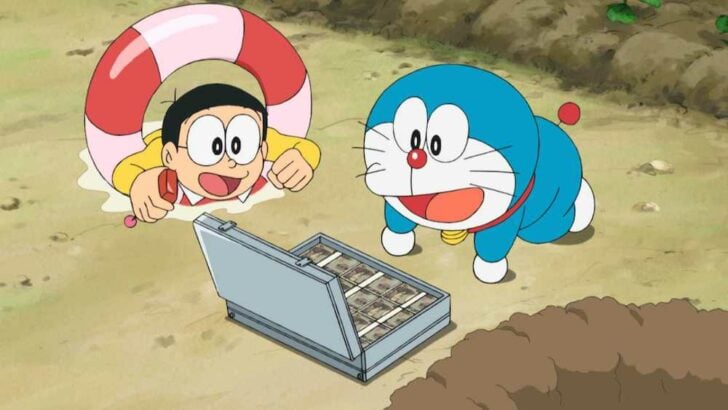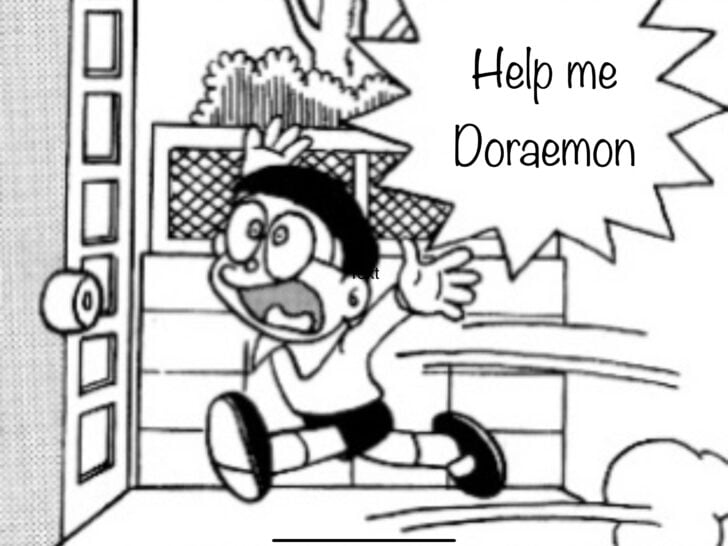Share on your favorite
Or copy the link
Below are navigation links that will take you to the main text and navigation menus.
26,551 first names, 70,620 last names, 333,585 kanji variations.
one of the best Japanese name search tools for your baby!

Image by: Official Doraemon Website ©Fujiko pro/Shogakukan ©Tv Asahi/Shinei/ADK
Contents
Doraemon is one of the most famous manga series in Japan, it is written and illustrated by Fujiko. F. Fujio. Doraemon is an earless cat robot who came from the future to help Nobita, a young boy who was going to have a miserable life due to his laziness and lack of talent. Doraemon has a special four-dimensional pocket that carries all sorts of interesting future gadgets to improve Nobita’s life. Well, the main purpose is to make Nobita a better person so each episode often ends in a way that Nobita relies too much on the gadgets but then learns a lesson.

Image by: Doraemon Comic Book 1 ©Fujiko pro/Shogakukan
‘Doraemon’(ドラえもん) is the title of both the Japanese and English version. The first two letters ‘Dora’(ドラ) are written in Katakana and the rest are in Hiragana.

Image by: Official Doraemon Website ©Fujiko pro/Shogakukan ©Tv Asahi/Shinei/ADK
In Japanese culture, names have significant meanings which are supposed to represent you as a person. Names can be expressed in hiragana, katakana and kanji. Let’s find out the meanings of some names of characters in Doraemon.

Image by: Official Doraemon Website ©Fujiko pro/Shogakukan ©Tv Asahi/Shinei/ADK
Doraemon, a very well known character in Japan. ‘Dora ドラ’ is taken from the word ‘Dora Neko’ which means stray cat. ‘Emon’ is an old fashioned ending for a boy’s name. As you can see from the title, Doraemon’s name is written both in Hiragana and Katakana which is quite unusual. The reason to this uniqueness was explained in one of the episodes when Doraemon was about to register his name at the robot townhall he forgot how to write ‘E’(え), ‘Mo’ (も), and ‘N’(ん) in Katakana so instead he decided to write them in hiragana.

Image by: Official Doraemon Website ©Fujiko pro/Shogakukan ©Tv Asahi/Shinei/ADK
Nobita is the main character of the series. He is lazy and doesn’t like to work hard but on the other hand, he is also very kind. ‘No’(野 )means field and ‘Bi’(比) means ratio. ‘Nobi’(のび) means to grow or stretch (the full word is Nobiru, 伸びる) and ‘Ta’(太) means extremely big.

Image by: Official Doraemon Website ©Fujiko pro/Shogakukan ©Tv Asahi/Shinei/ADK
Shizuka is a kind and gentle friend of Nobita. ‘Minamoto’(源) means the source of a stream. ‘Shizu’(静) means quiet and ‘Ka’(香) means fragrance.

Image by: Official Doraemon Website ©Fujiko pro/Shogakukan ©Tv Asahi/Shinei/ADK
Takeshi, also known as ‘Giant’ is very aggressive and always bullies Nobita. ‘Gou’(剛) means hard and strong, ‘Da’(田) or ‘Ta’ is a paddy field, and ‘Takeshi’(武) means force. A perfect name to suit his character and looks!

Image by: Official Doraemon Website ©Fujiko pro/Shogakukan ©Tv Asahi/Shinei/ADK
Along with his best friend Giant, Suneo enjoys bullying Nobita. ‘Hone’(骨) means bone, ‘Kawa’(川) means river. ‘Sune’ is written in Katakana and ‘O’(夫) means husband.
The word ‘sune’ is believed to be taken from the phrase ‘Oya no Sune wo Kajiru’(親の臑を嚙る) which means depending on your parents’ financial support. Born to a wealthy family, Suneo loves to show off his new toys and expensive gadgets.

Image by: Official Doraemon Website ©Fujiko pro/Shogakukan ©Tv Asahi/Shinei/ADK
Hidetoshi has a very interesting name, his family name ‘Dekisugi’ means too good. As you can tell from his name, Hidetoshi is a smart and hard-working boy. ‘De’(出) means out, ‘Ki’ (木) is a tree, ‘Sugi’(杉) is a type of tree called cedar, ‘Hide’(英) means excel, and ‘Sai’(才) means talent.
Here are some useful phrases from Doraemon which will help you along with your Japanese studies!

Image by: Official Doraemon Website ©Fujiko pro/Shogakukan ©Tv Asahi/Shinei/ADK
One of Nobita’s signature phrase which you will hear almost in all the episodes. Whenever Nobita is bullied by Giant of faces trouble he would go ‘Tasukete!’ which means help!

Image by: Official Doraemon Website ©Fujiko pro/Shogakukan ©Tv Asahi/Shinei/ADK
Dorayaki is a must-try Japanese pancake with red bean filling. ‘Daikoubutsu’ means the most favorite food!

Image by: Official Doraemon Website ©Fujiko pro/Shogakukan ©Tv Asahi/Shinei/ADK
‘Shukudai’ means homework, ‘owaru’ means finish, ‘made’ is yet. Nobita’s mother often says ‘Ikemasen’ which means cannot!
Sort by: Most Kanji Variations
Sorts names by how many different kanji spellings they have. In general, names with more variants tend to be more familiar and widespread in Japan (with some exceptions).
Sort by: Most Viewed
Sorts names by page views on this site. Views reflect global traffic (including Japan), so this does not represent popularity among Japanese people only. A high view count does not necessarily mean the name is famous in Japan.
What is Hiragana?
Hiragana is one of the two Japanese syllabaries. Each character represents a sound (mora), not a meaning. It is used for native words, grammatical particles, verb/adjective endings (okurigana), and to show pronunciation above kanji (furigana). It developed from cursive forms of kanji.
What is Katakana?
Katakana is one of the two Japanese syllabaries. Each character represents a sound (mora), not a meaning. It is mainly used to write foreign words and names, loanwords, onomatopoeia, and for emphasis.
What is English Transcription?
“English transcription” (romanization) is the romanized form of a Japanese name, intended to reproduce its pronunciation as closely as possible. It is also useful for searching names on this site.
Japanese-Style Nicknames
In Japan, nicknames are used to express familiarity and affection. Typical features include:
Shortened forms: Names are often shortened for closeness, e.g., “Yuki” from “Yukiko” or “Taka” from “Takashi”.
Suffixes: Terms like “-chan” (often for girls, also for young children) and “-kun” (often for boys) are used among family and close friends. Among very close adults, “-chan” may still be used. More details
Use & context: Nicknames are informal—common among friends, family, or close colleagues—and are not suitable for formal or professional settings. Their use implies a certain degree of intimacy.
Long vowels: The long vowel mark “chōonpu” (ー) extends the preceding vowel. For example, “あーちゃん” (A-chan) lengthens the “あ” sound.
Households
Sorts surnames by the estimated number of Japanese households that use them. More households generally indicates a more common or well-known surname.
About our last-name data
